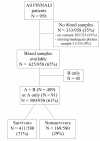Plasma cell-free DNA in patients needing mechanical ventilation
- PMID: 21838858
- PMCID: PMC3387638
- DOI: 10.1186/cc10357
Plasma cell-free DNA in patients needing mechanical ventilation
Abstract
Introduction: Concentrations of plasma cell-free DNA are increased in various diseases and have shown some prognostic value in many patient groups, including critically ill patients. Pathophysiological processes behind the need for mechanical ventilation and the treatment itself could raise plasma levels of cell-free DNA. We evaluated levels of plasma cell-free DNA and their prognostic value in patients needing mechanical ventilation.
Methods: We studied prospectively 580 mechanically ventilated critically ill patients. Blood samples were taken at study admission (Day 0) and on Day 2. Plasma cell-free DNA concentrations were measured by real-time quantitative PCR assay for the β-globin gene and are expressed as genome equivalents (GE)/ml.
Results: Median (interquartile range, IQR) plasma cell-free DNA concentration was 11,853 GE/ml (5,304 to 24,620 GE/mL) at study admission, and 11,610 GE/mL (6,411 to 21,558 GE/mL) on Day 2. Concentrations at admission were significantly higher in 90-day non-survivors than survivors, 16,936 GE/mL (7,262 to 46,866 GE/mL) versus 10,026 GE/mL (4,870 to 19,820 GE/mL), P < 0.001. In a multivariate logistic regression analysis plasma cell-free DNA concentration over 16,000 GE/ml remained an independent predictor of 90-day mortality (adjusted odds ratio 2.16, 95% confidence interval CI 1.37 to 3.40). Positive likelihood ratio of plasma cell-free DNA at admission for the prediction of 90-day mortality was 1.72 (95% CI 1.40 to 2.11).
Conclusions: Plasma levels of cell-free DNA were significantly higher in non-survivors than survivors. Plasma DNA level at baseline was an independent predictor of 90-day mortality. However, its clinical benefit as a prognostic marker seems to be limited.
Figures




Comment in
-
Diagnostic potential of circulating cell-free DNA in patients needing mechanical ventilation: promises and challenges.Crit Care. 2011;15(5):187. doi: 10.1186/cc10365. Epub 2011 Sep 12. Crit Care. 2011. PMID: 21978490 Free PMC article.
References
Publication types
MeSH terms
Substances
LinkOut - more resources
Full Text Sources

